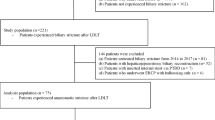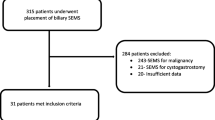Abstract
Background
Anastomotic bile duct stricture (ABS) is one of the most common complications after liver transplantation. Current practice of endoscopic retrograde cholangiopancreatography (ERCP) with multiple plastic stent (MPS) insertion often requires multiple sessions before achieving stricture resolution. We aimed to compare the efficacy of fully covered self-expandable metallic stent (FCSEMS) with MPS method while simultaneously analyzing the relative healthcare cost between the two methods in the management of ABS.
Methods
Liver transplant patients with ABS who received ERCP with stent placement were identified by query of our endoscopic database. Comparative analyses between the group of patients treated with ERCP with MPS and the group treated with FCSEMS were performed. The costs to achieve stricture resolution, and the rates of stricture resolution, recurrence and complications were also compared.
Results
A total of 158 patients underwent ERCP with stent insertion for the management of ABS. Of those, 49 patient received FCSEMS for their ABS while 109 patients were treated with MPS only. Our cost analysis showed early utilization of FCSEMS can deliver up to 25% savings in the total procedure cost while providing comparable rates of stricture resolution. The rates of technical success, stricture recurrence and adverse outcomes, and stricture free durations were also comparable between the two groups.
Conclusion
While providing efficacy and safety rates comparable to ERCP-MPS, the incorporation of FCSEMS at early stage of ABS management could provide a substantial savings by reducing the number of ERCP session to achieve stricture resolution. Optimization of the timing and duration of FCSEMS indwelling time needs further validation.



Similar content being viewed by others
References
Sharma S, Gurakar A, Jabbour N. Biliary strictures following liver transplantation: past, present and preventive strategies. Liver Transpl. 2008;14:759–769.
Verdonk RC, Buis CI, Porte RJ, et al. Anastomotic biliary strictures after liver transplantation: causes and consequences. Liver Transpl. 2006;12:726–735.
Welling TH, Heidt DG, Englesbe MJ, et al. Biliary complications following liver transplantation in the model for end-stage liver disease era: effect of donor, recipient, and technical factors. Liver Transpl. 2007;14:73–80.
Shin MJ, Cho JW. Advances in endoscopic management of biliary complications after living donor liver transplantation: comprehensive review of the literature. World J Gastroenterol. 2016;22:6173–6191.
Ryu CH, Lee SK. Biliary strictures after liver transplantation. Gut Liver. 2011;5:133–142.
Chaput U, Scatton O, Bichard P, et al. Temporary placement of partially covered self-expandable metal stents for anastomotic biliary strictures after liver transplantation: a prospective, multicenter study. Gastrointest Endosc. 2010;72:1167–1174.
Thuluvath PJ, Pfau PR, Kimmey MB, et al. Biliary complications after liver transplantation: the role of endoscopy. Endoscopy. 2005;37:857–863.
Holt AP, Thorburn D, Mirza D, et al. A prospective study of standardized nonsurgical therapy in the management of biliary anastomotic strictures complicating liver transplantation. Transplantation. 2007;84:857–863.
Albert JG, Filmann N, Elsner J, et al. Long-term follow-up of endoscopic therapy for stenosis of the biliobiliary anastomosis associated with orthotopic liver transplantation. Liver Transpl. 2013;19:586–593.
Poley JW, Lekkerkerker MN, Bruno MJ, et al. Clinical outcome of progressive stenting in patients with anastomotic strictures after orthotopic liver transplantation. Endoscopy. 2013;45:567–570.
Morelli J, Mulcahy HE, Draganov P, et al. Long-term outcomes for patients with post-liver transplant anastomotic biliary strictures treated by endoscopic stent placement. Gastrointest Endosc. 2003;58:374–379.
Kao D, Zepeda-Gomez S, Bain VG, et al. Managing the post-liver transplantation anastomotic biliary stricture: multiple plastic versus metal stents: a systematic review. Gastrointest Endosc. 2013;77:679–691.
Tabibian JH, Asham EH, Han S, et al. Endoscopic treatment of postorthotopic liver transplantation anastomotic biliary strictures with maximal stent therapy. Gastrointest Endosc. 2010;71:505–512.
Fernández-Simon A, Díaz-Gonzalez A, Cárdenas A, et al. Endoscopic retrograde cholangiography for biliary anastomotic strictures after liver transplantation. Clin Liver Dis. 2014;18:913–926.
Kahaleh M, Behm B, Clarke BW, et al. Temporary placement of covered self-expandable metal stents in benign biliary strictures: a new paradigm? Gastrointest Endosc. 2008;67:446–454.
Mahajan A, Ho H, Sauer B, et al. Temporary placement of fully covered self-expandable metal stents in benign biliary strictures: midterm evaluation (with video). Gastrointest Endosc. 2009;70:303–309.
Coté GA, Slivka A, Tarnasky P, et al. Effect of covered metallic stents compared with plastic stents on benign biliary stricture resolution: a randomized clinical trial. JAMA. 2016;315:1250–1257.
Tarantino I, Traina M, Mocciaro F, et al. Fully covered metallic stents in biliary stenosis after orthotopic liver transplantation. Endoscopy. 2012;44:246–250.
Vandenbroucke F, Plasse M, Dagenais M, et al. Treatment of post liver transplantation bile duct stricture with self-expandable metallic stent. HPB (Oxf). 2006;8:202–205.
Traina M, Tarantino I, Barresi L, et al. Efficacy and safety of fully covered self-expandable metallic stents in biliary complications after liver transplantation: a preliminary study. Liver Transpl. 2009;15:1493–1498.
Pfau P, Pleskow D, Banerjee S, et al. Status evaluation report: Pancreatic and biliary stent. Gastrointest Endosc. 2013;77:319–327.
García-Pajares F, Sánchez-Antolín G, Pelayo SL, et al. Covered metal stents for the treatment of biliary complications after orthotopic liver transplantation. Transpl Proc. 2010;42:2966–2969.
Jang S, Parsi M, Vargo J, et al. Efficacy and optimal duration of metallic stent in the management of refractory anastomotic stricture after liver transplantation. Clin Gastroenterol Hepatol. 2017;15:1776–1781.
Martins FP, De Paulo GA, Contini M, et al. Metal versus plastic stent for anastomotic biliary strictures after liver transplantation: a randomized controlled trial. Gastrointest Endosc. 2018;87:131–140.
Kaffes A, Griffin S, Vaughan R, et al. A randomized trial of a fully covered self-expandable metallic stent versus plastic stents in anastomotic biliary strictures after liver transplantation. Ther Adv Gastroenterol. 2014;7:64–71.
Williams T. Understanding hospital charges, costs and payments. https://strategicdynamicsfirm.com/understanding-hospital-charges-costs-and-payments. Retrieved December 14, 2015.
Andrews W, Cameron D. Disparity in medical billing. http://www.washingtonpost.com/wp-srv/special/national/actual-cost-of-medical-care/. Retrieved May 8, 2013.
Martin-Gomez LM, Sobrino-Rodriguez S, Alamo-Martinez JM, et al. Use of fully covered self-expandable stent in biliary complications after liver transplantation: A case series. Transpl Proc. 2010;42:2975–2977.
DaVee T, Irani S, Baron T, et al. Stent-in-stent technique for removal of embedded partially covered self-expanding metal stents. Surg Endosc. 2016;30:2332–2341.
Author information
Authors and Affiliations
Contributions
SJ was involved in study conception and design, acquisition and interpretation of data, drafting of manuscript, critical revision of the manuscript for important intellectual content, and final approval of manuscript. TS contributed to study design, analysis and interpretation of data, and critical revision of the manuscript for important intellectual content, and final approval of manuscript. RL was involved in statistical analysis and interpretation and critical revision of the manuscript for important intellectual content. AB was involved in acquisition and analysis of data, critical revision of the manuscript for important intellectual content, and final approval of manuscript. PC contributed to acquisition and analysis of data, critical revision of the manuscript for important intellectual content, and final approval of manuscript. MS was involved in acquisition of data, critical revision of manuscript for important intellectual content, and final approval of manuscript. JV contributed to study design, analysis of data, critical revision of the manuscript for important intellectual content, and final approval of manuscript.
Corresponding author
Ethics declarations
Conflict of interest
Dr. Jang reports conflict of interest with consulting service arrangement with Boston Scientific, outside the submitted work. Dr. Stevens reports conflict of interest with consulting service arrangement with Boston Scientific and AbbVie Pharmaceutical. Dr. Bhatt declares no conflict of interest. Dr. Sanaka declares no conflict of interest. Dr. Chahal declares no conflict of interest. Dr. Vargo declares no conflict of interest. Ms. Lopez declares no conflict of interest.
Additional information
Publisher's Note
Springer Nature remains neutral with regard to jurisdictional claims in published maps and institutional affiliations.
Electronic Supplementary Material
Below is the link to the electronic supplementary material.
Rights and permissions
About this article
Cite this article
Jang, S., Stevens, T., Lopez, R. et al. Self-Expandable Metallic Stent Is More Cost Efficient Than Plastic Stent in Treating Anastomotic Biliary Stricture. Dig Dis Sci 65, 600–608 (2020). https://doi.org/10.1007/s10620-019-05665-9
Received:
Accepted:
Published:
Issue Date:
DOI: https://doi.org/10.1007/s10620-019-05665-9




